Макиавелли Николай. Государь (Il Principe) и Рассуждения на первые три книги Тита Ливия. Пер. c итал. Н. Курочкина. Издание "Русской книжной торговли". - СПб.; тип. Тиблена и Ко. (Неклюдова), 1869. - 502 стр.
-
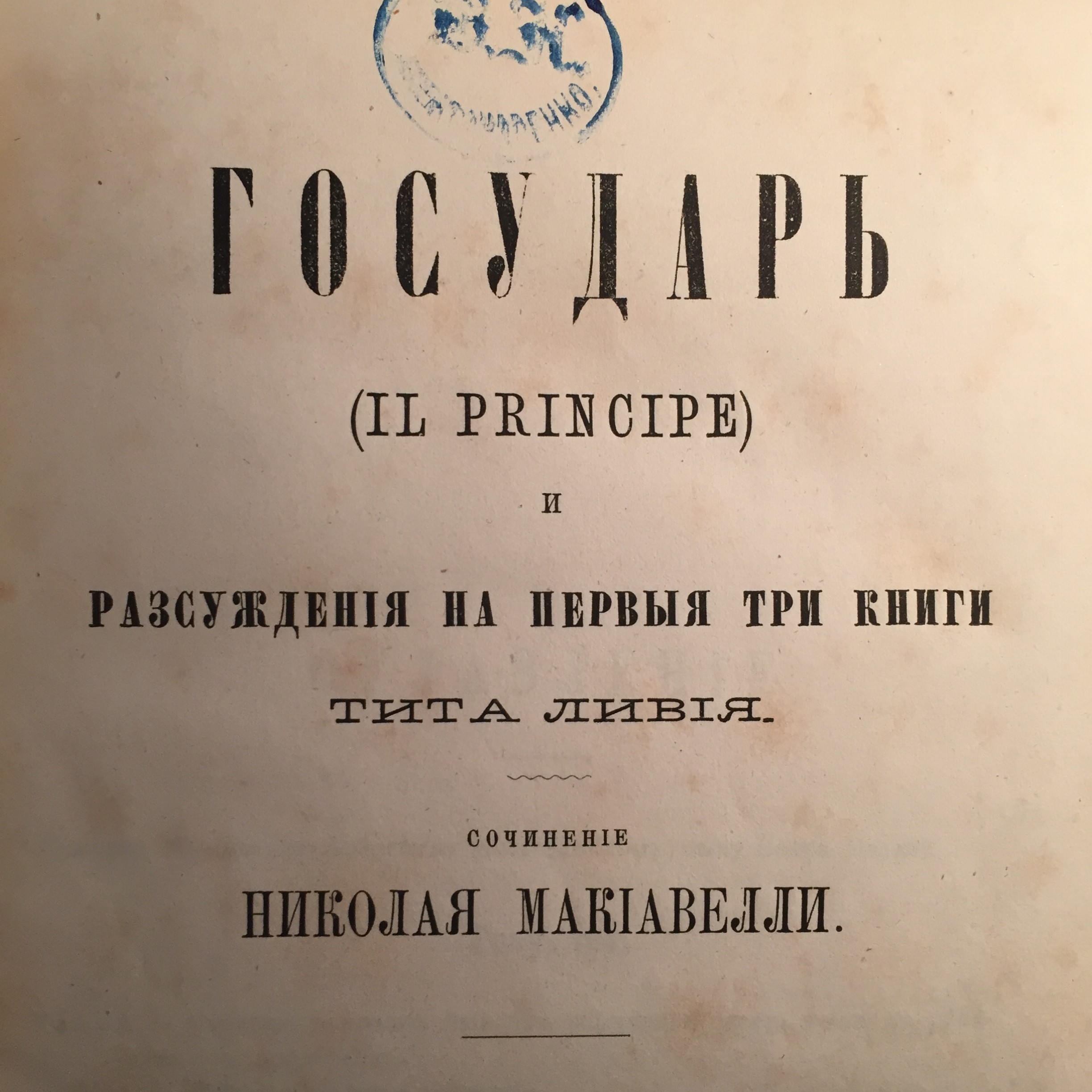
-
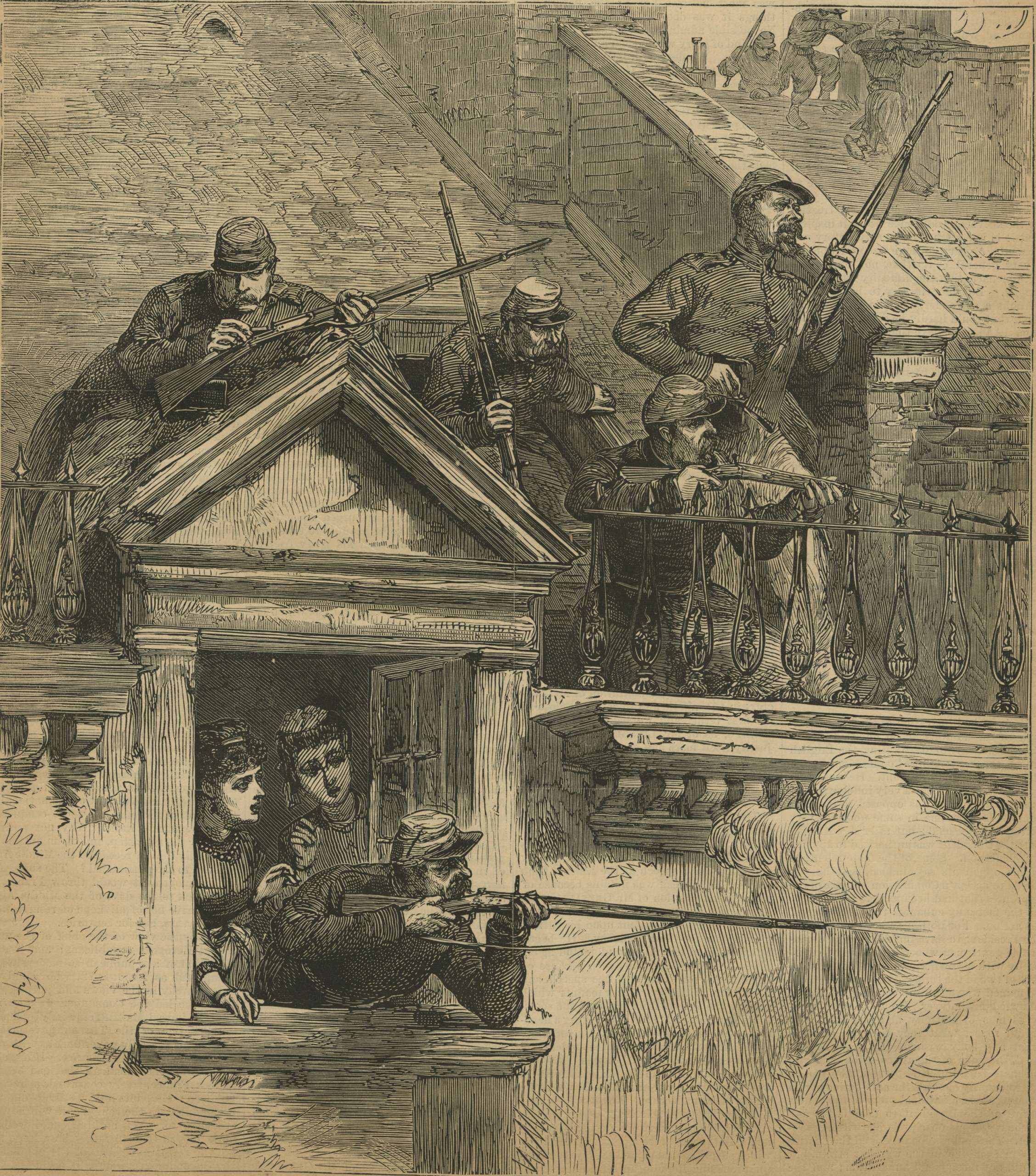
-
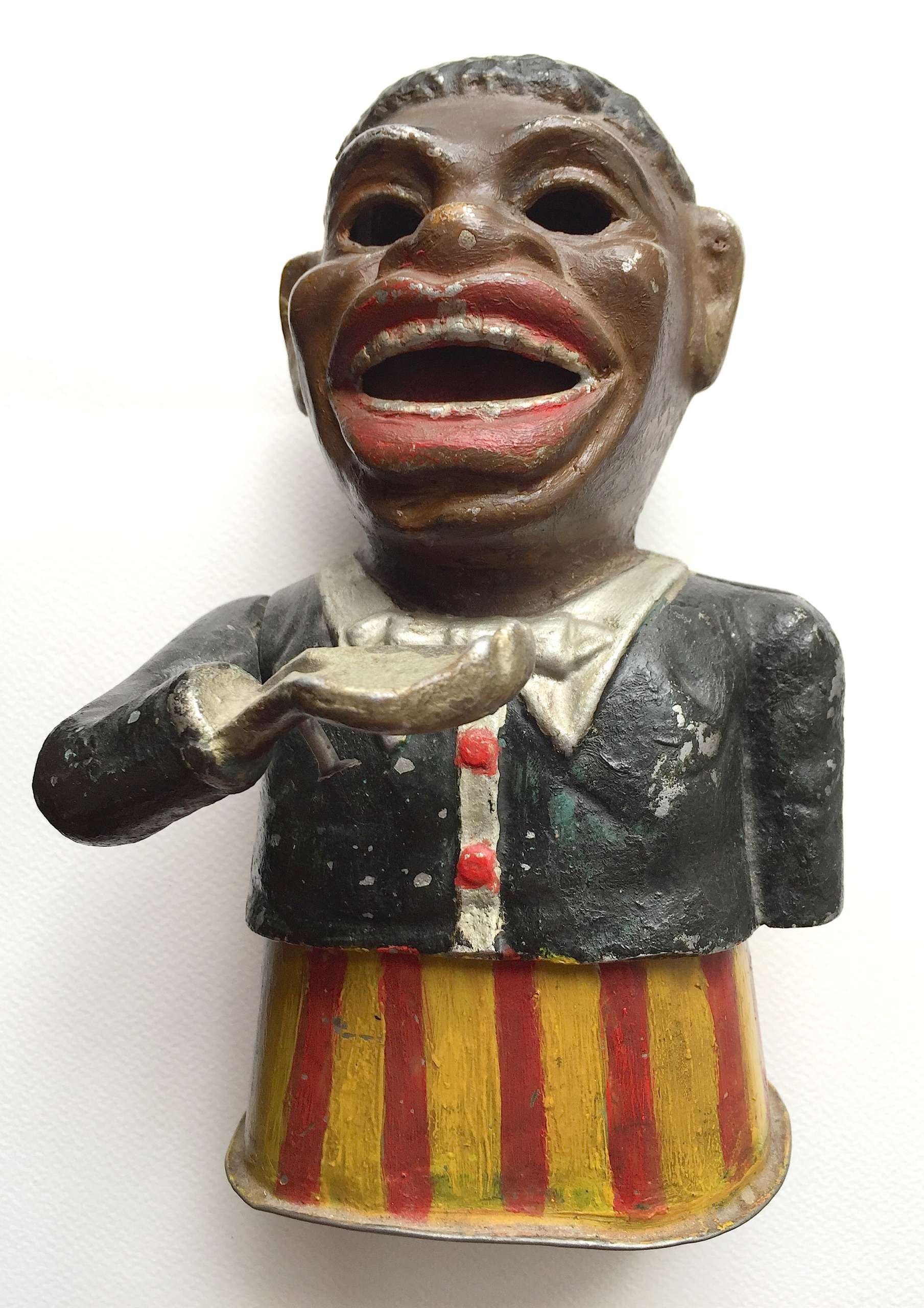 A cast iron painted 19th century style money box in the form of a negro, the arm articulated to insert coins.
A cast iron painted 19th century style money box in the form of a negro, the arm articulated to insert coins. -
 Iron tsuba of round form with design of butterfly (left) and dragonfly (right) in openwork (sukashi), outlined with brass wire. Thin plate also decorated with five concentric circular rows of brass dots (nail heads) in ten-zōgan; brass wire outlines of the center of the plate. School: Ōnin ten-zogan. Late Muromachi period, 16th century. Diameter: 88 mm, thickness at seppa-dai: 3.1 mm. Another tsuba of similar design, Tōshō school, is illustrated in this collection; see TSU-0353.Reference to the design has been found at "Japanese Swords and Tsuba from the Professor A. Z. Freeman and the Phyllis Sharpe Memorial collections". Sotheby's, London, Thursday 10 April 1997; p. 18, item 37: "pierced with two large formalised butterflies...".
Iron tsuba of round form with design of butterfly (left) and dragonfly (right) in openwork (sukashi), outlined with brass wire. Thin plate also decorated with five concentric circular rows of brass dots (nail heads) in ten-zōgan; brass wire outlines of the center of the plate. School: Ōnin ten-zogan. Late Muromachi period, 16th century. Diameter: 88 mm, thickness at seppa-dai: 3.1 mm. Another tsuba of similar design, Tōshō school, is illustrated in this collection; see TSU-0353.Reference to the design has been found at "Japanese Swords and Tsuba from the Professor A. Z. Freeman and the Phyllis Sharpe Memorial collections". Sotheby's, London, Thursday 10 April 1997; p. 18, item 37: "pierced with two large formalised butterflies...".
TSU-0353: Tōshō tsuba, Muromachi period.

A kamakura-bori tsuba. Momoyama period. Freeman & Sharpe Memorial Collections.
-
 Iron tsuba of round form with circular iron wire fastened to the surface with iron and brass staples (mukade-zōgan); brass ring about 2.5 mm wide along the rim with chisel marks. Design repeats on the reverse. Copper sekigane. Early Edo, 17th century. Size: Height: 83.3 mm; width 83.9 mm; thickness at seppa-dai: 4.5 mm. Weight 173.6 g. Design is thought to resemble a centipede. "Centipede-like inlay (mukade zogan) of alternating iron and brass staples produce an appearance that was particularly favored by Takeda Shingen (1521-1573), one of the most powerful warlords of his time. The centipede is sacred to Bishamon (God of War) and especially propitious for a warrior. Shingen type, 16th century.” [The Peabody Museum collection of Japanese sword guards with selected pieces of sword furniture, by John D. Hamilton. Photographs by Mark Sexton. Salem, MA, 1975.] See also: http://varshavskycollection.com/shingen-tsuba/ SOLD
Iron tsuba of round form with circular iron wire fastened to the surface with iron and brass staples (mukade-zōgan); brass ring about 2.5 mm wide along the rim with chisel marks. Design repeats on the reverse. Copper sekigane. Early Edo, 17th century. Size: Height: 83.3 mm; width 83.9 mm; thickness at seppa-dai: 4.5 mm. Weight 173.6 g. Design is thought to resemble a centipede. "Centipede-like inlay (mukade zogan) of alternating iron and brass staples produce an appearance that was particularly favored by Takeda Shingen (1521-1573), one of the most powerful warlords of his time. The centipede is sacred to Bishamon (God of War) and especially propitious for a warrior. Shingen type, 16th century.” [The Peabody Museum collection of Japanese sword guards with selected pieces of sword furniture, by John D. Hamilton. Photographs by Mark Sexton. Salem, MA, 1975.] See also: http://varshavskycollection.com/shingen-tsuba/ SOLD -
 Kitagawa Utamaro. According to Chris Uhlenberg this is an illustration from the book Ehon koi no Onamaki, 3 vols, published in Kansei 11 (1799). Illustrated in b/w in: Hayashi Yoshikazu: Kitagawa Utamaro, in the series: Edo makura-e shi shusei, published in 1990, reissued 1994. Size: Chuban (25.5 x 18.5 cm), two book pages glued together.
Kitagawa Utamaro. According to Chris Uhlenberg this is an illustration from the book Ehon koi no Onamaki, 3 vols, published in Kansei 11 (1799). Illustrated in b/w in: Hayashi Yoshikazu: Kitagawa Utamaro, in the series: Edo makura-e shi shusei, published in 1990, reissued 1994. Size: Chuban (25.5 x 18.5 cm), two book pages glued together. -
 [SOLD]
[SOLD]Iron tsuba of slightly elongated round form carved and inlaid in gold and shibuichi with a long-armed monkey hanging from a pine tree branch reaching for the reflection of a crescent moon in the stream. A pine tree carved with details inlaid in gold on the reverse. The design seems to be inspired by Kaneie work (Compton III, p. 10, №6a; Tsuba no bi, 1947, p. 33, №56).
Dimensions: 76.8 x 74.2 x 3.6 mm. Mid-Edo period. Unsigned.
Compton III, p. 10, №6a

Tsuba no bi, 1947, p. 33, №56.
-
 Iron tsuba of oval form with the motif of horse trappings in openwork (sukashi). Copper sekigane. Iron bones (tekkotsu) on the rim.
Iron tsuba of oval form with the motif of horse trappings in openwork (sukashi). Copper sekigane. Iron bones (tekkotsu) on the rim.Size: 80.4 x 75.8 x 5.2 mm
NBTHK Certificate №454567, allegedly saying that it is Akasaka School, Muromachi period. A look-a-like tsuba in Robert. E. Haynes Catalog #7, 1983 on page 57 under №48 is described as follows: "A masterpiece second period Owari sukashi tsuba. The plate is of beautiful color and quality almost like velvet. The design is very hard to discern, it might be the horse trappings, or even a moon. The style and type of Owari tsuba shows the great tradition of the Momoyama period and why it was the renaissance in time, as well as the arts produced, through the long history of all Japanese art. Ca. 1580. Ht. 7.7 cm, Th. (center) 5.5 mm, (edge) 5.25 to 5.75 mm."I believe we can safely attribute this tsuba to Owari School, c. 1580.
Robert. E. Haynes Catalog #7, 1983, p. 57, №48.
-
 Isoda Koryūsai (礒田 湖龍斎, 1735–1790), flourished: 1769 to 1790. The print lacks signature (signature erased).
Isoda Koryūsai (礒田 湖龍斎, 1735–1790), flourished: 1769 to 1790. The print lacks signature (signature erased).Attributed definitely to Koryūsai: Jacob Pins, #491 [p.202] - Saigyo Hoshi admiring Mount Fuji. Signature erased but convincingly attributed to Koryusai. Tikotin Museum, Haifa. Catalogue raisonné: Allen Hockley: A3-J-5 (p. 261).
Saigyō Hōshi (西行 法師, 1118 – March 23, 1190) was a famous Japanese poet of the late Heian and early Kamakura period. -

Iron tsuba of round form with brown patina decorated with the design of a Buddhist temple bell (tsurigane) in openwork (sukashi), with details outlined in brass wire (sen-zōgan), the outer ring decorated with two rows of brass dots (ten-zōgan), and the bell details carved in sukidashi-bori as on kamakura-bori pieces.
Ōnin school. Unsigned. Late Muromachi period, 16th century. Dimensions: 88.8 x 88.3 x 3.0 mm. As per Merrily Baird, two legends are usually associated with the image of tsurigane, a large, suspended Buddhist bell: one is that of Dojo Temple (Dojo-ji), and the other is of Benkei stealing the tsurigane of Miidera Temple. Interestingly, this type of bell (tsurigane) is not described as a family crest (mon), while suzu and hansho bells are. -

Iron tsuba with hammer marked surface and design of a plum and cherry blossoms to the right of nakaga-ana in openwork (sukashi). Raised rim, typical to katchushi school. The thickness of the plate provides for later Muromachi period making.
Late Muromachi period (1514-1573). Size: 85.8 x 85.0 x 3.6 (center), 4.1 (rim) mm; weight: 136 g. -
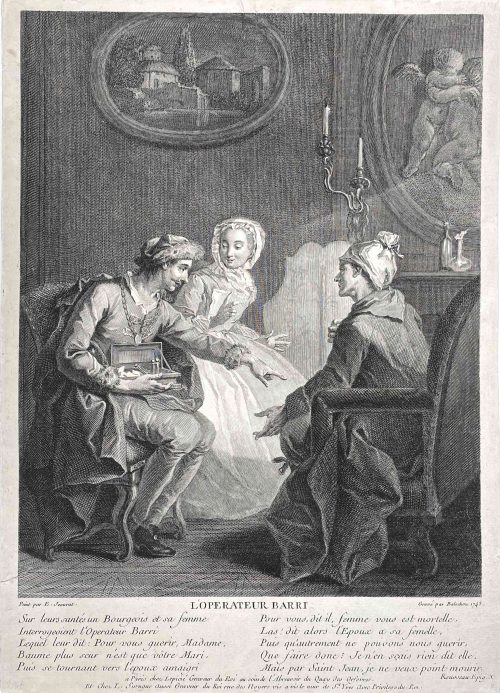
Engraving by J.J. Balechou after E. Jeaurat. A husband and wife ask a quack doctor for advice about health: he suggests substituting himself for the husband in the wife's affections, and she agrees: Épigrammes de Jean-Baptiste Rousseau (French, 1671–1741).
Date: 1743.
Size: 380 x 270 mm
Inscriptions under the image:
Top: Peint par E. Jeaurat | L'Operateur Barri | Grave par Balechou 1743
Middle: Sur leurs santés un Bourgeois et sa femme
Interrogeoient l'Operateur Barri, Lequel leur dit : Pour vous guérir, Madame, Baume plus sûr n'est que votre Mari, Puis se tournant vers l'époux amaigri, Pour vous, dit il, femme vous est mortelle, Las ! dit alors l'Epoux à sa femelle, Puis qu'autrement ne pouvons nous guérir, Que faire donc ? Je n'en sçai rien, dit elle,Mais, par Saint Jean, je ne veux point mourir.
Rousseau Epig. X
Center bottom: a Paris chez Lepicie Graveur du Roi au coin de l'Abreuvoir du Quay des Orfevres. Et Chez L. Surugue Aussi Graveur du Roi rue des Noyers vis a vis le mur de St. Yves Avec Privilege du Roi. -
 Artist: Utagawa Sadahide [歌川 貞秀], a.k.a. Gountei Sadahide [五雲亭 貞秀] (1807 – c. 1878/9). Publisher: Iseya Ichiemon [伊勢屋市右衛門] (Japanese, fl. c 1823 – 1864), seal name Kaku-Tsuji [角辻]. Signed: Gountei Sadahide ga [五雲亭貞秀画] Censor's seal: kiwame, date seal: Tenpō 3 (1832). Size: Uncut fan print (uchiwa-e); 218 x 282 mm. Portrait of a young woman dressed in a green kimono decorated with arabesque (karakusa) and flowers, her black obi adorned with a dragon, in a western-style frame, on a blue background; and a painting of a parrot on a pomegranate tree. A similar design was used by Sadahide in 1860, described in detail by Sebastian Izzard in his Japanese Prints of the Mid-Nineteenth Century: 1830–1865, September 20–October 24, 2006 exhibition: Picture of a Curio Shop in Yokohama: reverse painting on glass of a crimson parrot, coloured copperplate engraving of a mother and child (Yokohama urimono mise no zu: gyokuban abura-e, doban-e saishiki). Colour woodblock print: oban tate-e, 143/8 x 93/4 in. (36.5 x 24.8 cm.); Man-en I/3 (3/1860) Series: Picture of Goods for Sale in Yokohama (Yokohama urimono zue no uchi) Signature: Gountei Sadahide ga, double toshidama seal Publisher: Daikokuya Kinnosuke.
Artist: Utagawa Sadahide [歌川 貞秀], a.k.a. Gountei Sadahide [五雲亭 貞秀] (1807 – c. 1878/9). Publisher: Iseya Ichiemon [伊勢屋市右衛門] (Japanese, fl. c 1823 – 1864), seal name Kaku-Tsuji [角辻]. Signed: Gountei Sadahide ga [五雲亭貞秀画] Censor's seal: kiwame, date seal: Tenpō 3 (1832). Size: Uncut fan print (uchiwa-e); 218 x 282 mm. Portrait of a young woman dressed in a green kimono decorated with arabesque (karakusa) and flowers, her black obi adorned with a dragon, in a western-style frame, on a blue background; and a painting of a parrot on a pomegranate tree. A similar design was used by Sadahide in 1860, described in detail by Sebastian Izzard in his Japanese Prints of the Mid-Nineteenth Century: 1830–1865, September 20–October 24, 2006 exhibition: Picture of a Curio Shop in Yokohama: reverse painting on glass of a crimson parrot, coloured copperplate engraving of a mother and child (Yokohama urimono mise no zu: gyokuban abura-e, doban-e saishiki). Colour woodblock print: oban tate-e, 143/8 x 93/4 in. (36.5 x 24.8 cm.); Man-en I/3 (3/1860) Series: Picture of Goods for Sale in Yokohama (Yokohama urimono zue no uchi) Signature: Gountei Sadahide ga, double toshidama seal Publisher: Daikokuya Kinnosuke.
-
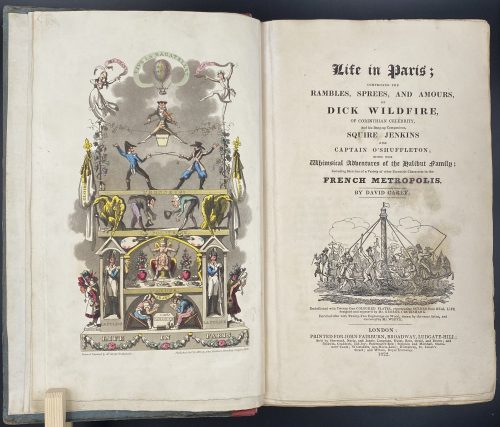
Title: Life in Paris ; | COMPRISING THE | RAMBLES, SPREES, AND AMOURS, | OF | DICK WILDFIRE, | OF CORINTHIAN CELEBRITY, | And his Bang-up Companions, SQUARE JENKINS | AND | CAPTAIN O’SHUFFLETON ; | WITH THE | Whimsical Adventures of the Halibut family ; | Including Sketches of a Variety of other Eccentric Characters in the | FRENCH METROPOLIS. | BY DAVID CAREY |[Vignette]| Embellished with Twenty-One COLOURED PLATES, representing SCENES from REAL LIFE, | designed and engraved by Mr. GEORGE CRUIKSHANK. | Enriched also with Twenty-Two Engravings on Wood, drawn by the same Artist, and | executed by Mr. WHITE. | LONDON : | PRINTED FOR JOHN FAIRBURN, BROADWAY, LUDGATE HILL; | Sold by Sherwood, Neely, and Jones ; Langman, Hurst, Rees, Orme, and Brown ; and | Baldwin, Craddoc, and Joy ; Paternoster-Row ; Simpkin and Marshall, Statio- | ners’ Court ; Whittakers Ave-Maria-Lane ; Humphrey, St. James’s | Street ; and Wilson, Royal Exchange. | 1822. ||
Edition: 1st edition in book form, 1st issue; large-paper copy bound from the parts in original blue paper boards, "most scarce" (Cohn).
Pagination: ffl, [i, ii] – h.t. ‘LIFE IN PARIS’ / ‘MARCHANT, Printer, Ingram-Court, London’, [2] – blank / Frontispiece (Ville la Bagatelle!!) hand-coloured, [iii, iv] – t.p. with vignette / blank, [v] vi-xxiv, [1] 2-489 [490 blank], [2] – 'TO THE BINDER' and 'Marchant, Printer, Ingram-Court, Fenchurch Street' "considered indispensable to a complete copy" (Cohn) / blank, bfl watermarked 1800; 21 hand-coloured aquatints and 22 wood-engraved text vignettes; cancelled leaves 143/4 and 335/6; pinholes from printing visible in most gatherings.
Collation: 4to; [a]-c4, B-Z4 Aa-Zz4 3A-3Q4 3R1 + [Ω]1
Binding: Original boards sometime re-backed with red paper, binder's end leaf watermarked 1800; red hard-grained morocco clamshell box.
Catalogue raisonné: Albert M. Cohn, 1924: № 109 p. 37/8; Abbey, J. R. (Life in England), 112; Tooley (Some English Books with Coloured Plates) 129; Hardie (English coloured books) 199.
Description of Shapero Rare Books, London: Of the copies that have come to auction since 1975 only one has been a large-paper copy in original boards. "The pictures are extremely spirited and true and are all the more wonderful in view of the fact that the artist’s continental experiences were limited to one day spent in Boulogne." (Hardie). In 1821, the journalist Pierce Egan published Life in London, an immediate success illustrated by the Cruikshank brothers, George and Robert. In order to capitalise on this success, another journalist, David Carey, decided to publish his own Life in Paris in monthly instalments (just like Life in London) and with a very similar frontispiece to the one that appears in Egan’s work; Life in Paris, however, was illustrated only by George Cruikshank. One of the earliest and most notable examples of the work of George Cruikshank, with fine, clean plates. -
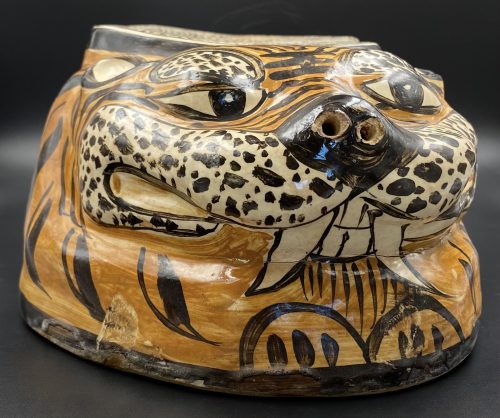 The pillow is moulded as a recumbent tiger, the details painted in dark brown and pale russet on a white slip and under a clear glaze, and the slightly dished top is painted with a winged beast. China, the Jin dynasty [金朝] (1115 – 1234). Dimensions: 12 x 34.5 x 19.5 cm
The pillow is moulded as a recumbent tiger, the details painted in dark brown and pale russet on a white slip and under a clear glaze, and the slightly dished top is painted with a winged beast. China, the Jin dynasty [金朝] (1115 – 1234). Dimensions: 12 x 34.5 x 19.5 cm -
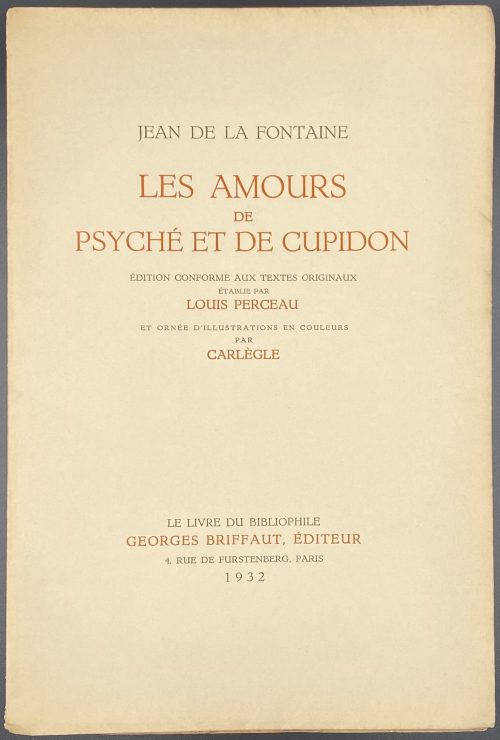 Softcover, 242 x 165 mm, French flapped wrappers with black and red lettering to front and spine, top edge trimmed, pages uncut, printed on wove paper watermarked BFK Rives in italic script; illustrations in colour. Title: JEAN DE LA FONTAINE | LES AMOURS | DE | PSYCHÉ ET DE CUPIDON | ÉDITION CONFORME AUX TEXTES ORIGINAUX | ÉTABLIE PAR | LOUIS PERCEAU | ET ORNÉE D’ILLUSTRATIONS EN COULEURS | PAR | CARLÈGLE | LE LIVRE DU BIBLIOPHILE | GEORGES BRIFFAUT, ÉDITEUR | 4, RUE DE FURSTENBERG, PARIS | 1932 || Limited edition: 1230 copies of which this ic copy № 247. Collated 8vo: π4 1-24 3-48 58 *58 6-168 χ2, total 134 leaves, incl. frontispiece. Pagination: [8] 1-253 [254] [6]. Colophon: Le volume des Amours de Psyché et de Cupidon de La Fontaine a été achevé d'imprimer le quinze juin mil neuf cent trente-deux sur les presses du maitre imprimeur Coulouma, a Argenteul, H. Barthélemy étant directeur. Coloris de E. Charpentier, Paris.
Softcover, 242 x 165 mm, French flapped wrappers with black and red lettering to front and spine, top edge trimmed, pages uncut, printed on wove paper watermarked BFK Rives in italic script; illustrations in colour. Title: JEAN DE LA FONTAINE | LES AMOURS | DE | PSYCHÉ ET DE CUPIDON | ÉDITION CONFORME AUX TEXTES ORIGINAUX | ÉTABLIE PAR | LOUIS PERCEAU | ET ORNÉE D’ILLUSTRATIONS EN COULEURS | PAR | CARLÈGLE | LE LIVRE DU BIBLIOPHILE | GEORGES BRIFFAUT, ÉDITEUR | 4, RUE DE FURSTENBERG, PARIS | 1932 || Limited edition: 1230 copies of which this ic copy № 247. Collated 8vo: π4 1-24 3-48 58 *58 6-168 χ2, total 134 leaves, incl. frontispiece. Pagination: [8] 1-253 [254] [6]. Colophon: Le volume des Amours de Psyché et de Cupidon de La Fontaine a été achevé d'imprimer le quinze juin mil neuf cent trente-deux sur les presses du maitre imprimeur Coulouma, a Argenteul, H. Barthélemy étant directeur. Coloris de E. Charpentier, Paris. -
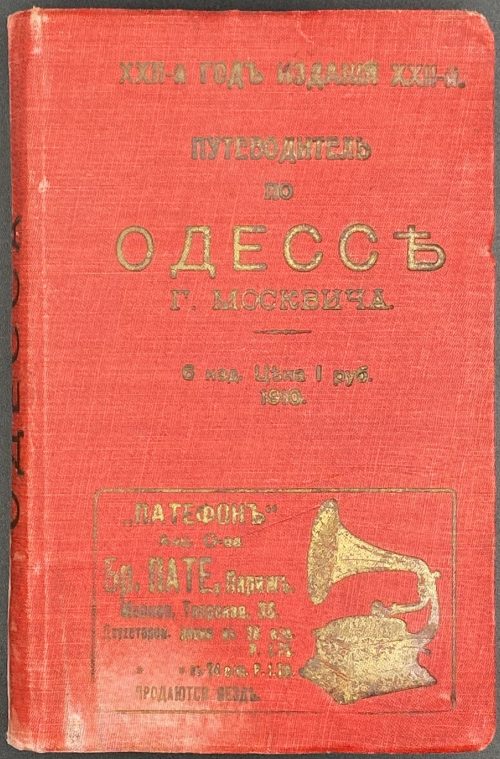 Title: Издательство Путеводителей "Русскiй Бедекеръ" сущ. съ 1888 г. | Григорiй Москвичъ. | ИЛЛЮСТРИРОВАННЫЙ | Практический Путеводитель | по Одессѣ | с приложенiемъ: | очерка одесской выставки, плана Одессы, исполненнаго | в краскахъ, плановъ — порта, Куяльницкаго лимана, | расписанiя рейсовъ пароходовъ и тарифовъ, алфавита | и проч. | ИЗДАНИIЕ ШЕСТОЕ. | Цѣна 1 руб. (в переплетѣ) | ПРОДАЕТСЯ | во всѣх лучшихъ книжныхъ магазинахъ столицъ | и провинцiи. | ОДЕССА. | Типографiя и стереотипия И. Копельмана, Пушк. 34. | 1910. || Binding: Red cloth with gilt lettering to the front board: XXII-й ГОДЪ ИЗДАНIЯ XXII-й | ПУТЕВОДИТЕЛЬ | ПО | ОДЕССѢ | Г. МОСКВИЧА. | 6 изд. Цѣна 1 руб. | 1910. [Pictorial advert.], to the back board: Text. advert. in gilt; to spine: ОДЕССА. Pink end-papers with advertisement. Pagination: [i-ii - t.p. /advert.] [iii]-iv - preface to 6th edition; [v]-viii - content; [ix]-xvi - index; 11 leaves advert., unpag; [i]-xii - Odessa exhibition; [1] 2-240; [1] 2-8 - schedules; photo plates, 2 folding maps; in-16mo (numerical). Size: 16.5 x 10.5 cm.
Title: Издательство Путеводителей "Русскiй Бедекеръ" сущ. съ 1888 г. | Григорiй Москвичъ. | ИЛЛЮСТРИРОВАННЫЙ | Практический Путеводитель | по Одессѣ | с приложенiемъ: | очерка одесской выставки, плана Одессы, исполненнаго | в краскахъ, плановъ — порта, Куяльницкаго лимана, | расписанiя рейсовъ пароходовъ и тарифовъ, алфавита | и проч. | ИЗДАНИIЕ ШЕСТОЕ. | Цѣна 1 руб. (в переплетѣ) | ПРОДАЕТСЯ | во всѣх лучшихъ книжныхъ магазинахъ столицъ | и провинцiи. | ОДЕССА. | Типографiя и стереотипия И. Копельмана, Пушк. 34. | 1910. || Binding: Red cloth with gilt lettering to the front board: XXII-й ГОДЪ ИЗДАНIЯ XXII-й | ПУТЕВОДИТЕЛЬ | ПО | ОДЕССѢ | Г. МОСКВИЧА. | 6 изд. Цѣна 1 руб. | 1910. [Pictorial advert.], to the back board: Text. advert. in gilt; to spine: ОДЕССА. Pink end-papers with advertisement. Pagination: [i-ii - t.p. /advert.] [iii]-iv - preface to 6th edition; [v]-viii - content; [ix]-xvi - index; 11 leaves advert., unpag; [i]-xii - Odessa exhibition; [1] 2-240; [1] 2-8 - schedules; photo plates, 2 folding maps; in-16mo (numerical). Size: 16.5 x 10.5 cm. -
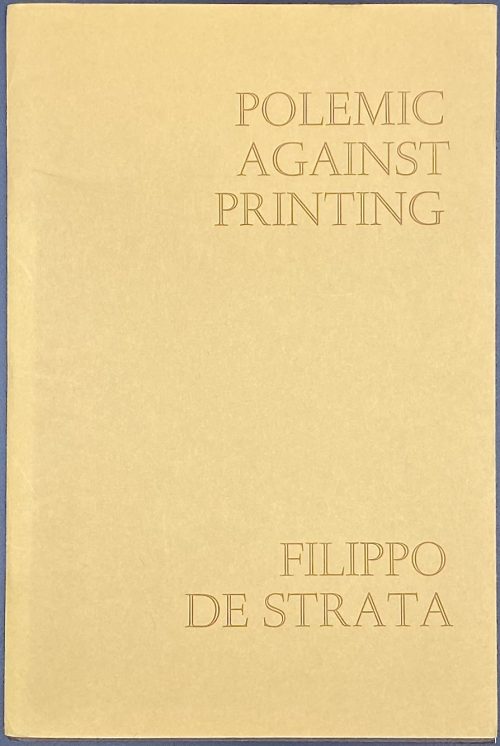 POLEMIC AGAINST PRINTING | by | FILIPPO DE STRATA | Translated by SHELAGH GRIER | Edited and | Introduced by MARTIN LOWRY | University of Warwick | The Hayloft Press | 1986 || Publisher’s mustard wrappers w/ lettering, 18.5 x 12.5 cm, 20 unnumbered pages of parallel Latin text and English translation with English introduction; limited edition of 350 copies, 100 for private circulation and 250 numbered copies for sale of which this is №3, with ink inscription to the last page: To Beryl | on her birthday, 1986 | with love from | David ||
POLEMIC AGAINST PRINTING | by | FILIPPO DE STRATA | Translated by SHELAGH GRIER | Edited and | Introduced by MARTIN LOWRY | University of Warwick | The Hayloft Press | 1986 || Publisher’s mustard wrappers w/ lettering, 18.5 x 12.5 cm, 20 unnumbered pages of parallel Latin text and English translation with English introduction; limited edition of 350 copies, 100 for private circulation and 250 numbered copies for sale of which this is №3, with ink inscription to the last page: To Beryl | on her birthday, 1986 | with love from | David ||


